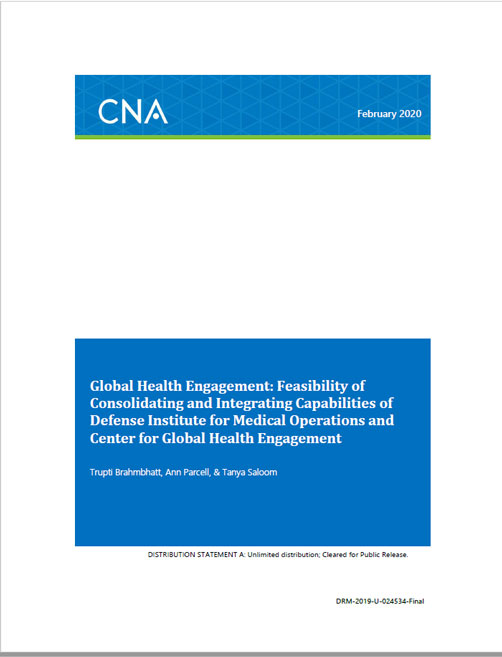Global Health Engagement:
Global Health Engagement (GHE) related education and training of the U.S. and international militaries are important missions but are carried out by disparate organizations in the military health system. Two such organizations, Center for Global Health Engagement (CGHE) and Defense Institute for Medical Operations (DIMO) are the subjects of this study. The 2019 House Arms Services Committee (HASC) report asked the Secretary of Defense to provide a briefing on consolidation and integrating capabilities of these organizations. Specifically the report expressed concern over potential duplication of efforts and raised the possibility of efficiency gains through economies of scale.
We compared and contrasted CGHE and DIMO and studied both organizations by conducting literature review, discussions with the organization’s staff, leadership and other subject matter experts using RACI matrix, value proposition, and value chain mapping, and finally putting all the observations and findings in DOTmLPF framework. We also added funding, relationships, efficiency, and effectiveness attributes to the DOTmLPF framework.
We point out that CGHE does much more than training, in fact only one CGHE directorate— Training and Professional Development Directorate (TPD)—trains the U.S. military in GHE-related topics. DIMO trains international militaries in GHE related topics. Another major difference between the TPD and DIMO is the funding. TPD is funded by a single source- Uniformed Service university while DIMO is funded by a variety of sources. Lastly, TPD trains on what global health engagement is while DMO trains on how to conduct health related activities.
Despite the differences, we find that the DIMO and CGHE capabilities can be integrated. To minimize the disruptions to ongoing training missions, we recommend that the processes for funding be set up and the contract personnel hired via the Henry Jackson Foundation. We also looked at other organization options based on the attributes of an ideal organization—a joint organization with consistent resources and robust internal and external processes to help meet the CCMDs requirements and to ultimately meet the objectives of the campaign plans. We list three courses of actions and evaluate them against the attributes of an ideal organization. Finally, we recommend that a broader integration of GHE related education and training be explored.
Download reportUnlimited distribution; Cleared for Public Release.
Details
- Pages: 52
- Document Number: DRM-2019-U-024534-Final
- Publication Date: 2/20/2020
